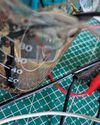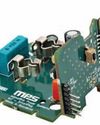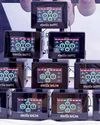MOBILE HOTSPOT/ TETHERING UNIT CHARGING
Electronics For You
|September 2024
Using ESP RainMaker App

Connecting to a wireless LAN network is a popular option for accessing internet-based applications. A readily available alternative is tethering or using a mobile hotspot, which allows the sharing of a smartphone’s mobile data to connect other devices to the internet. Most Android smartphones offer the capability to share mobile data through Wi-Fi, Bluetooth, or USB. Tethering effectively transforms a smartphone into a Wi-Fi access point, providing connectivity for laptops, tablets, microcontrollers, and low-power systems-on-chips (SoCs).
In areas with cellular network coverage, tethering offers the advantage of internet access from virtually anywhere, eliminating the need for separate data plans for each device. When password protection is enabled, tethering also ensures a cost-effective and secure internet connection across multiple devices. However, this method can significantly drain the smartphone’s battery, leading to more frequent recharging, which may reduce the convenience and flexibility typically associated with tethering.
To address the issue of rapid battery discharge during tethering, a setup utilising an ESP32 development board controlled via the ESP RainMaker app is proposed. This configuration includes four parallel systems, each operating on a separate SoC, to collect data and manage various functions during testing. To ensure continuous 24/7 connectivity, the smartphone serving as the mobile hotspot or tethering unit was physically recharged at specific intervals. A critical aspect of this setup is establishing a node through the ESP RainMaker app, which mitigates the problem of faster battery depletion in the tethering smartphone. Fig. 1 shows the authors’ prototype.

This story is from the September 2024 edition of Electronics For You.
Subscribe to Magzter GOLD to access thousands of curated premium stories, and 10,000+ magazines and newspapers.
Already a subscriber? Sign In
MORE STORIES FROM Electronics For You

Electronics For You
Tech Majors Are Racing TOWARDS NET-ZERO - What About You?
Apple, Microsoft, Amazon, Google, Infosys, Wipro—global and Indian firms are heading closer to achieving net-zero emissions, a mandate to combat climate change. Here is what you need to know to start your journey...
12 mins
December 2025

Electronics For You
Miniature IoT WATER TDS And LEVEL MONITOR Cum CONTROLLER
For setups that rely on stored water, clear awareness of tank level and water quality is essential.
3 mins
December 2025

Electronics For You
The Impact Of GENERATIVE AI On The Future Of AUTOMOTIVE AND EVs
Autonomous vehicles, connected ecosystems, and smart factories are only the beginning. Generative Al is pushing the auto industry beyond predictions into a bold era of creativity-from EV design to real-time diagnostics and showroom automation. Here is how GenAl is reshaping innovation across the automotive value chain.
8 mins
December 2025

Electronics For You
How AI Tools Are Making SOFTWARE DEVELOPMENT BETTER
AI is reshaping how we code, debug, and collaborate. From Copilot to automation, it is changing software development in ways worth exploring.
3 mins
December 2025
Electronics For You
How AI Tools Are Making SOFTWARE DEVELOPMENT BETTER
AI is reshaping how we code, debug, and collaborate. From Copilot to automation, it is changing software development in ways worth exploring.
3 mins
December 2025

Electronics For You
5 Interesting Reference Designs FOR SMART HOMES
Smart home devices are transforming the way people interact with their appliances. They make homes more convenient, secure, and energy-efficient. From smart plugs and energy monitors to smart locks and thermostats, reference designs help design engineers create connected products that are easy to use, consume less power, and are reliable. These designs allow you to control devices remotely, track energy use, extend battery life, and automate routines. They provide practical solutions for upgrading homes and small commercial spaces without major modifications.
3 mins
December 2025

Electronics For You
Fancy USB LED VASE
This USB LED vase is a simple yet elegant device that fuses art with electronics to create a decorative lighting display. Powered directly from a standard USB port, it uses readily available components such as MOSFETs, resistors, capacitors, and LEDs to produce a striking, dynamic sequence of lights.
3 mins
December 2025

Electronics For You
"WHAT OTHERS SELL IN FOUR BOXES WE BUILT IN ONE"
Years of custom field work are shaping a product line with its own cloud, its own hardware, and a market that is now beginning to recognise its value.
8 mins
December 2025

Electronics For You
BUILD LARGE LANGUAGE MODELS
Large language models are machine learning models designed for a range of language-related tasks such as text generation and translation. Here’s how open source software can help you build your own large language model.
6 mins
December 2025

Electronics For You
Rare Earth Or Rare Ingenuity? India Remains Between The Two
With China firmly controlling rare earth exports, India confronts a critical moment in its technological trajectory.
8 mins
December 2025
Listen
Translate
Change font size

